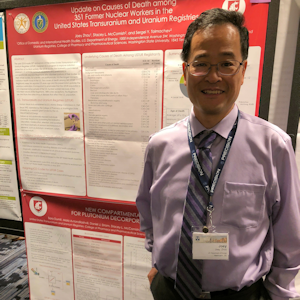64th Annual Meeting of the Radiation Research Society, Chicago, IL, September 23-56, 2018

The 2018 Radiation Research Society Meeting was held in conjunction with the Conference on Radiation & Health. USTUR faculty participated in both meetings. Recent USTUR research was presented at the RRS meeting as two posters, which summarized (1) the causes of death among 351 former nuclear workers , and (2) the final findings of USTUR/College of Pharmacy student, Sara Dumit’s, doctoral research on plutonium decorporation therapy.
Update on causes of death among 351 former nuclear workers in the United States Transuranium and Uranium Registries
Joey Zhou (US Department of Energy), Stacey L. McComish (USTUR), Sergei Y. Tolmachev (USTUR)
The year 2018 marks 50th anniversary of the United States Transuranium and Uranium Registries (USTUR). Designed as a program to improve radiation protection of nuclear workers, the USTUR studies the biokinetics and internal dosimetry of actinides (uranium, plutonium, and americium) in occupationally exposed Registrants who volunteer portions of their bodies, or their whole bodies, for scientific use posthumously. It is the longest-running domestic radiation health study in the U.S. The causes of death among 260 USTUR Registrants were first reported 20 years ago and this presentation updates the previous publication. It is important to emphasize that the USTUR population is not a representative sample of the U.S. nuclear workers because of the volunteer nature of the Registrants. With a few exceptions, the Registrants died from the same kinds of diseases that affect the U.S. population. [USTUR-0499-18A]
New compartmental model for plutonium decorporation therapy
Sara Dumit (USTUR), Maia Avtandilashvili (USTUR), Daniel J. Strom (USTUR), Stacey L. McComish (USTUR), George Tabatadze (USTUR), Sergei Y. Tolmachev (USTUR)
Individuals with a significant internal deposition of plutonium typically undergo medical treatment with chelating agents that form stable complexes with plutonium and accelerate its removal from the body. The trisodium salt of calcium diethylenetriaminepentaacetate (Ca-DTPA) is commonly used as a decorporation drug. Since plutonium biokinetics is strongly affected by complexation with the chelating agent, standard biokinetic models cannot be used directly to estimate the intake and radiation dose. A new 5-compartment model for plutonium decorporation therapy was developed using the Coordinated Network for Radiation Dosimetry (CONRAD) approach, which describes the kinetics of the in vivo chelation process. New assumptions and parameters were proposed to account for both the intravenously injected Ca-DTPA and the in vivo formed Pu-DTPA chelate. Modeling was performed using SAAM II® software. For model development, parameterization, and validation, data from a USTUR whole-body donor (Case 0212) were used. This individual had plutonium intake due to a contaminated puncture wound and underwent extensive treatment with Ca-DTPA. For model development, urine bioassay data were used. Post-mortem plutonium activities in the liver and the skeleton were used for the initial model validation. The proposed model more accurately describes urinary excretion and long-term retention of plutonium in tissues, when compared to the original CONRAD model. [USTUR-0504-18A]